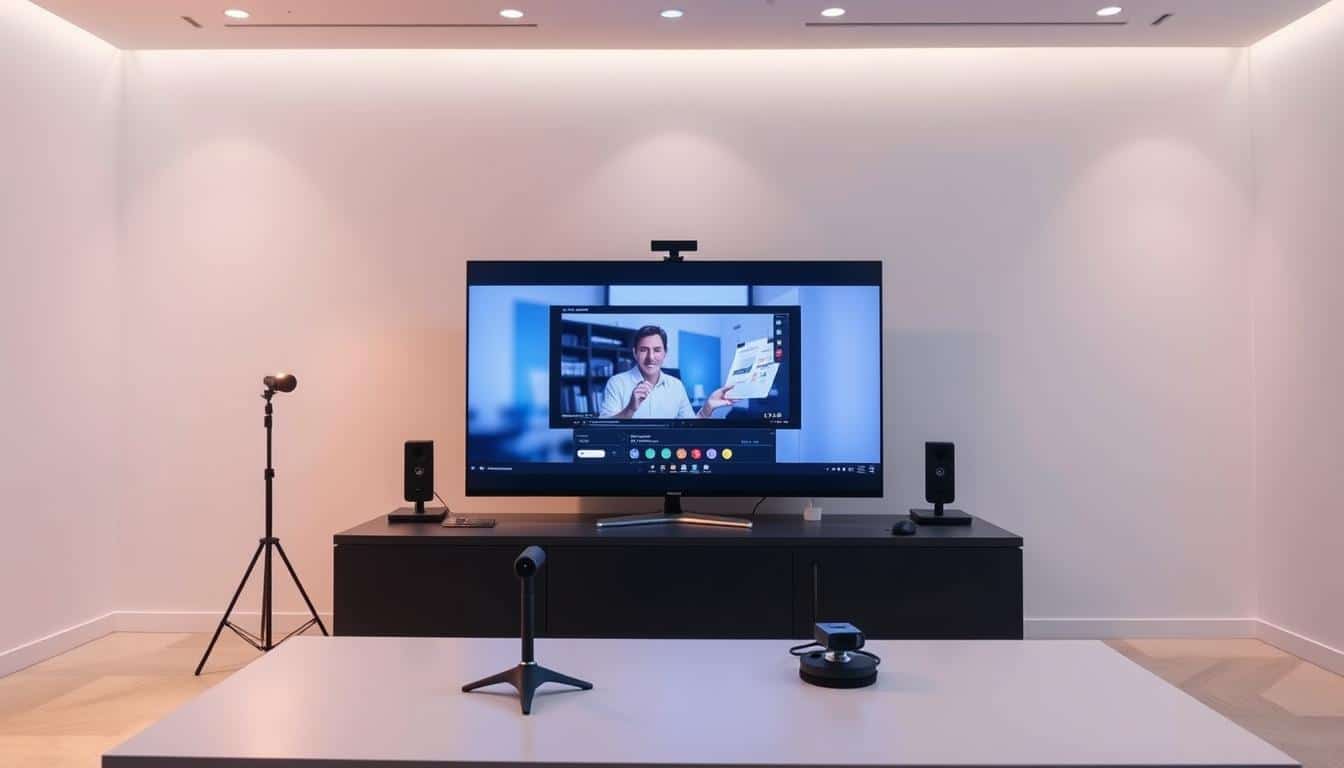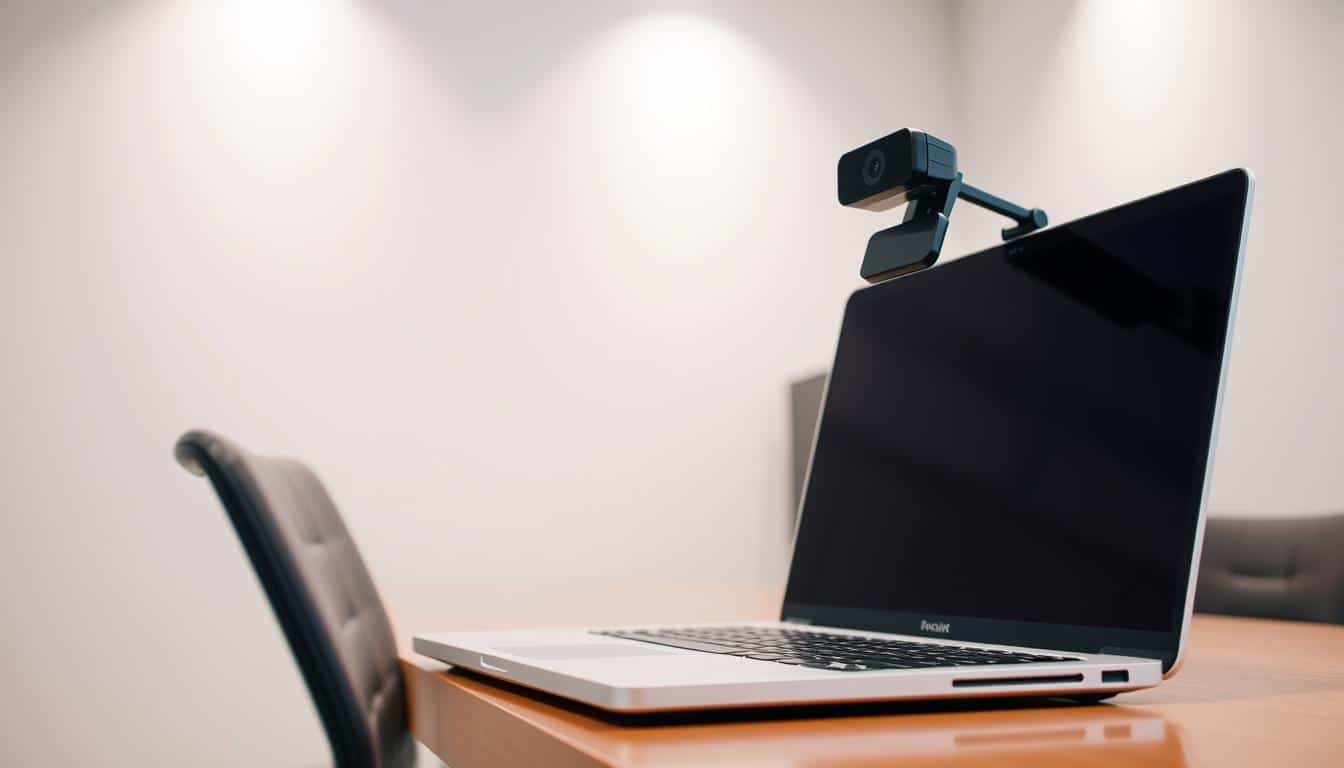Today, setting up an effective virtual meeting room is super important. To communicate clearly and boost productivity, organizations must work on their virtual meeting setups. A well-set meeting room makes everyone feel part of the team, no matter where they are.
Choosing top-notch audio-visual equipment and planning the room layout matters a lot. It doesn’t matter if it’s for quick discussions or hybrid events. A great virtual meeting space helps people work together better. By investing in a good setup, you’ll see more participation and better project outcomes.
Anúncios
Introduction to Virtual Meeting Room Optimization
Workplace dynamics have evolved, making virtual meetings key for teamwork. To work well remotely, it’s important to optimize your virtual meeting space. This includes using the right tech, setting up effectively, and training users to enhance meeting experiences.
Almost all businesses, 94%, see how video conferencing boosts work efficiency. To support hybrid teamwork, 38% of bosses are updating their video conferencing tech. Platforms like Zoom, Microsoft Teams, and Google Meet meet various needs. BrainCert offers special options for eLearning and teaming up.
Virtual rooms offer HD video, screen sharing, and whiteboards for better teamwork. These tools are great for teams worldwide to talk clearly, even across areas like New York and Tokyo. Recent findings show 62% of leaders think video calls are much clearer than just voice calls.
Another plus is saving money. Virtual rooms can cut costs by 30% over face-to-face meetings. By setting a clear plan and using good security, meetings become more engaging and safe. Focusing on clear audio, video, and good lighting makes virtual rooms work well, leading to success.
The Importance of a Functional Meeting Room Setup
A good meeting room setup is key to a great meeting experience. It can really help teams work well together and be more productive. When everyone is comfortable and can easily take part, they can share their thoughts and work together better.
On the other hand, a bad setup can cause distractions. It can make it hard for people to focus and work together, which is the whole point of meetings.
There are different setups like boardroom, U-shape, or classroom styles for various kinds of meetings. Each one supports different levels of talking and working together. For example, a U-shape setup is better for discussions than a classroom setup.
- Important items for a good meeting room include top-notch cameras, microphones, speakers, and video monitors.
- Good sound, lighting, and how the furniture is arranged can make the room more welcoming.
- Having the right tech and a reliable internet connection makes sure everyone can talk easily, no matter if they’re there or joining from far away.
It’s important to keep track of how meeting rooms are used. This helps improve how the space and meetings are planned. By using what we learn from past meetings, rooms can be set up in the best way for what’s needed.
Tools like YAROOMS help manage when rooms are available and what equipment is needed. Digital signs can also show what’s happening in the room right now. Putting money into a good meeting room setup is crucial. It supports teamwork and helps a company do well.
Key Components of a Virtual Meeting Room Setup
Setting up an effective virtual meeting room requires a few key things that can greatly improve your video calls. Making sure you use a good camera and the right lighting can change how people see and interact in meetings.
Quality Camera Options for Remote Meetings
Choosing a good camera is vital for virtual meetings. You should think about getting high-definition webcams or external cameras. They offer better pictures, auto-focus, and zoom. Products like the Logitech Rally or the AVer CAM340+ give great visual quality. They work well for both small and large meetings. Using a better camera than your laptop’s can make your calls look more professional.
Essential Lighting Techniques for Enhanced Visibility
Good lighting is key to a clear video in video conferences. Make sure light comes from in front of you to light up your face. Avoid light behind you as it can make shadows and distract others. Using softbox lights or ring lights helps spread the light evenly. This makes you look better on camera.
Understanding the C.L.A.S.S.Y. Framework
The C.L.A.S.S.Y. framework highlights key parts for better virtual meetings. It covers Camera, Lights, Audio, Setup, Stage, and You. The camera’s role and lighting are vital for a professional look. Here’s how to improve these two main parts.
The Role of Camera in Your Setup
Where your camera is placed greatly affects your look in meetings. Having it at eye level makes things feel more real and lively. To get the best image, try using an external camera instead of the built-in one. This ensures your video is clear and professional.
Lighting Considerations for Virtual Engagement
Good or bad lighting can change how your video looks. It’s best to use natural daylight and sit close to a window. Don’t have light behind you, as it makes you look dark. Adding a ring light above your eyes cuts down on glare and makes you easier to see.
Test your lighting by using Zoom’s “Join” button or the ‘Photobooth’ app on a Mac. Make sure to have a simple, clean wall behind you. Stay away from messy backgrounds that can distract viewers.
Audio: The Backbone of Effective Communication
Good audio quality is key for smooth and effective virtual meetings. Bad audio can cause misunderstandings and frustration, hurting teamwork. By upgrading to better audio equipment, teams communicate more clearly and work better together.
Upgrading Your Audio Equipment
Buying better audio equipment can really improve how you communicate in virtual meetings. Here are some ways to make your audio better:
- Beamforming microphones target the speaker’s voice, significantly reducing background noise.
- Ceiling-mounted speakers provide even sound distribution, ensuring all participants hear clearly.
- Install echo cancellation technology to prevent audio feedback during discussions.
- Consider using AI-powered features for noise cancellation, improving the overall audio experience.
- For larger meeting rooms, multi-camera setups guarantee that all participants remain visible and engaged.
Common Pitfalls in Virtual Meeting Audio
Knowing the common pitfalls can help you avoid problems that mess up communication. Here are some things to keep an eye on:
- Neglecting regular updates and upgrades can result in compatibility issues with evolving technologies.
- Ignoring room acoustics may lead to echo and unclear audio, frustrating participants.
- Failing to manage background noise effectively can distract and disrupt meetings.
- Not preparing the audio setup ahead of time, such as muting notifications, can divert attention from the discussion.
- Overlooking the importance of reliable AV systems can hinder productivity and lead to dissatisfaction among employees.
Setup Strategies for a Professional Virtual Experience
Setting up a professional virtual space requires careful planning. Start with the right technology, furniture, and decor. This makes the meeting look good and keeps distractions low. A tidy area helps everyone stay focused and join in more.
Here are smart ways to make your virtual setup work better:
- Password-protect meetings to prevent unauthorized access.
- Only allow meeting hosts to initiate the call, controlling participant entry.
- Share meeting invite links through secure communication channels.
- Regularly update video conferencing software to address potential security issues.
- Avoid sharing sensitive files during video calls; use emails or secure platforms instead.
Virtual meeting rooms come with great features. They have video and audio calls, chats, ways to share files, and tools for working together. Platforms like Zoom, ClickMeeting, and Google Meet have special things for different needs. This could be for telemedicine or court hearings.
You can set up a good virtual space quickly with RingCentral. It lets you make a meeting ID and password fast. You can also add your logo or choose a nice background. This makes your virtual space look more professional.
Creating a Stage for Your Virtual Meetings
A well-organized virtual meeting stage can really make a difference. It helps keep participants focused and engaged. By having a neat environment and thoughtful decor, you minimize distractions. This makes the meeting feel more professional and keeps everyone connected.
Minimizing Distractions in Your Background
Choosing a simple backdrop helps you look your best during virtual meetings. Here’s what you can do:
- Create a dedicated workspace to avoid home interruptions.
- Ensure proper lighting to make sure you’re seen without shadows.
- Place furniture and equipment so everyone’s visible and audible.
- Check your tech before meetings to prevent any hiccups.
Choosing Appropriate Decor for Engagement
Decor matters a lot in making a virtual space inviting. To improve your meeting space, consider these tips:
- Use high-definition cameras and screens for a crisp appearance.
- Set up the room and camera to keep everyone in view.
- Try theater-style seating for large groups, but think about its effect on interactions.
- Use U-shaped setups to spur conversations between speakers and the audience.
- Adjust seating to help everyone engage without obstacles.
Leveraging Technology in Your Virtual Meeting Room Setup
To upgrade your virtual meeting room, you need a good plan for tech. Using cool collaboration tools can make talking and working together much better during meetings. For example, Zoom’s AI Director can change the camera view to focus on who’s talking, making the meeting feel more alive. Nowadays, having lots of tech features that work well together is key for an awesome meeting space.
Integrating Tools for Seamless Collaboration
For a top-notch virtual meeting area, mix advanced tech and smart gadgets. Your options include:
- Compact conferencing cameras and wireless screen-sharing technology for effective huddle rooms.
- High-resolution PTZ cameras along with advanced speakerphones and multi-display setups for larger conference environments.
- Ultra HD video conferencing equipped with AI-powered auto-framing cameras and professional-grade sound systems for boardrooms.
- AI-driven engagement tools and 360-degree conference cameras designed for hybrid meetings.
- Real-time feedback systems from Microsoft Places and Cisco Spaces that monitor air quality, lighting, and noise levels.
Smart planning and tools that check if meeting spaces are free help use rooms better. AI and smart sensors create places for quick, unplanned meetings, making the office more flexible.
The Importance of Stable Internet Connections
A strong internet connection is a must for virtual meetings. An ethernet link is more reliable than Wi-Fi, important for not losing connection. A good internet setup keeps away tech problems, making discussions more effective.
Different Meeting Room Layouts and Their Uses
Choosing the right layout for a meeting room is important. It affects how people interact and the success of the meeting. There are different layouts for different types of meetings. They help in how people connect with the content and each other.
This is very important for hybrid meetings that mix in-person and online attendees. These meetings need special designs to be successful.
Understanding Front Row Experiences for Hybrid Meetings
The Front Row Experience helps a lot in hybrid meetings. It makes everyone feel closer to the action by arranging seats in a semi-circle or U-shape. This setup makes it easy for everyone, whether they are there in person or joining online, to see the speaker well.
This way of setting up a meeting helps everyone feel included. It makes a community feeling that’s hard to get when some people are not physically there.
Choosing the Right Layout for Your Meeting Type
Different meeting room layouts are good for different purposes. Picking the right one makes your meeting more effective:
- Conference Style: Best for small to medium group discussions, encouraging collaboration and direct communication.
- Auditorium Style: Great for large presentations, ideal for keeping focus on the speaker while maximizing seating capacity.
- Workshop Style: Fosters interaction through tables arranged for collaboration, perfect for training and brainstorming sessions.
- Horseshoe Style: Combines presentation and interaction spaces, beneficial for training sessions or discussions.
- Banquet Style: Suitable for informal gatherings and networking, allowing flexibility for food setups.
- Hollow Square Style: Facilitates open discussions, excellent for committee meetings or brainstorming.
- Dynamic Style: Provides flexibility for various formats, perfect for spaces hosting diverse meeting types.
Adapting these layouts helps you meet your meeting’s goals. This makes the experience better for everyone involved.
Prioritizing Comfort Within the Virtual Meeting Space
Having a cozy virtual meeting space is key for keeping everyone engaged and productive. Choosing the right furniture helps people stay focused, even in long meetings. It’s also important that everyone can easily keep their devices charged. This makes sure discussions go smoothly without any breaks.
Ergonomic Furniture for Extended Meeting Sessions
Getting the right furniture for virtual meetings helps everyone feel good. Here’s why it’s good:
- Chairs that support your back make you less tired.
- Desks that can be adjusted fit everyone’s needs.
- Chairs at the right height keep your neck and shoulders relaxed, so you can concentrate better.
This kind of furniture keeps you comfortable, so you can focus and take part in meetings without feeling sore.
Access to Power: A Must-Have
Having power outlets close by is essential for good virtual meetings. Each workspace should have:
- Enough outlets for all your gadgets, like laptops and phones.
- Ways to keep cords tidy to stay safe and organized.
- USB ports for quick charging, so there’s no waiting around.
These setups help you stay plugged in and focused on the conversation. You won’t have to worry about your device dying, keeping the meeting smooth.
Incorporating the Latest AV Technology for Enhanced Engagement
Using the newest AV technology is key to making virtual meetings lively and engaging. It meets the growing need for interaction and teamwork. By adding modern audio-visual systems, the conversations among participants become better.
Utilizing Interactive Displays and Smart Technology
Interactive displays and smart tech change how teams have meetings. They offer features like:
- Touchless controls for easy use and better hygiene.
- AI-driven automation to simplify tasks and boost engagement.
- Support for immersive virtual reality applications, making presentations more exciting.
Companies can use LED video walls for sharp, eye-catching visuals. This keeps everyone interested and helps in working together better.
Choosing the Right AV System for Your Needs
It’s important to pick the right AV systems for a great meeting experience. AV companies provide services such as:
- Consultation to figure out what you need technically.
- Custom design and installation for your meeting space.
- Linking video conferencing tech with platforms like Zoom and Microsoft Teams.
- Regular updates and support to keep things running smoothly.
With their help, your organization can grow AV solutions as technology advances. Unified communications and collaboration solutions let you set up everything in one go. This makes virtual meetings simple to run.
Staff Training and User-Friendliness
Training staff well is key to making sure they are ready to use technology in virtual meetings. User-friendly technology helps make things run smoothly and gets more people involved. When we train everyone on the tech we’re using, meetings online get a lot better.
Ensuring Everyone is Comfortable with Technology
For technology to blend in smoothly, organizations should look at these strategies:
- Create a knowledge base utilizing resources like presentations, videos, and quizzes for easily accessible training materials.
- Set clear learning objectives for the training sessions, ensuring they remain focused and relevant to the participants’ needs.
- Utilize tools like Visme to deliver visually engaging and interactive training content.
- Incorporate analytics tools to track engagement and retention rates during these sessions.
Training Techniques for Optimal Use of Equipment
Using certain techniques can really boost how well staff training goes:
- Choose virtual meeting platforms that offer a simple, click-to-join option, making it accessible for less tech-savvy users.
- Ensure a clean, intuitive interface with clearly labeled buttons to minimize the need for extensive training.
- Provide comprehensive support resources, such as user guides, FAQs, and responsive customer support for smoother adoption.
- Invest in high-quality AV equipment to foster effective communication and alleviate technical troubleshooting challenges.

Conclusion
Today, it’s key to make virtual meetings better to work well together and make good decisions. It’s important to have the best video and audio gear, organize the room well, and teach users how to use it. These steps help make meetings more interesting, get everyone involved, and increase work done.
Before meetings, test everything like mics, cameras, and your internet. Also, having a quiet room that’s well lit and looks professional makes a big difference. Being on time and following meeting rules helps everyone get the most out of online meetings.
Companies like BCS Consultants offer customized help that includes the latest tech and effective room setups. By adding technology, comfort, and security, organizations can create a better and more professional meeting environment. This complete way of improving virtual meetings is crucial in a world that’s more and more online.
FAQ
What equipment do I need for a successful virtual meeting setup?
How can I ensure quality audio during virtual meetings?
What is the C.L.A.S.S.Y. framework for optimizing virtual meetings?
How important is lighting in a virtual meeting setup?
What layout should I choose for my virtual meetings?
How can I minimize distractions during virtual meetings?
What role does comfort play in virtual meeting setups?
How does technology integration impact virtual meetings?
Why is staff training necessary for virtual meetings?
Conteúdo criado com auxílio de Inteligência Artificial



